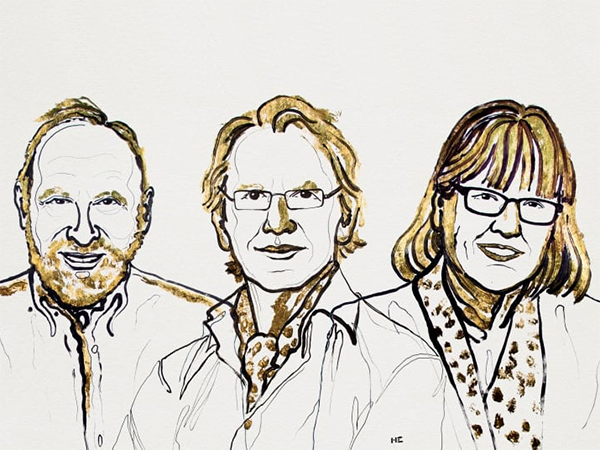The 2018 Nobel Prize in Physics was greeted with great surprise by the worldwide scientific community, at least for three reasons.
One: everyone expected it to be awarded to the scientists that a little over one year ago had measured gravitational waves for the first time.
Two: one of the winners is the oldest Nobel Laureate (96) and the third woman to win the Nobel Prize in Physics (after Maria Gopper Mayer in 1953 and Marie Sklodowska Curie in 1903).
Three: the prize wasn’t split in equal parts, like in the past, but with one half going to the American Arthur Ashkin, and the other half jointly to the French Gerard Mourou and to the Canadian Donna Strickland. The Royal Swedish Academy of Sciences wanted to place different applications under “ground-breaking inventions in the field of laser physics”. Let’s see them.
Optical tweezers (Ashkin)
Let’s say a gas is inside a sealed box. We know that the gas exercises a pressure on the box, a thermodynamic quantity that can be measured macroscopically. But what’s its microscopic origin?
The answer lies in the interactions between the gas molecules and the walls of the box: when they “bounce” they exercise a force hence a pressure on the walls that depends on the molecule interactions.
But what happens with a laser beam instead of molecules? Maxwell had already predicted that an electromagnetic wave exercises a pressure when it hits a surface, but the effect is so small that it was thought not to have any practical utility.
In 1964 Tawnes, Basov and Prokhorov received the Nobel Prize in Physics for inventing laser a decade earlier. Typical of many lasers is that they are almost monochromatic and very intense, so it’s intuitive that they may exercise greater pressure than normal electromagnetic waves.
In fact, back in the late 1960’s, Arthur Ashkin found a way to move colloidal spheres (micrometric in size, equal to one thousandth of a hair’s thickness) soaked in a water solution and contained in a glass box.
This wasn’t the most interesting part of these experiments, but the spheres were directed to the centre where the laser beam was more intense because the pressure also varied depending on the radiation intensity.
Ashkin understood that he had found a way to trap some very small objects with the light of a laser and that this could be used, for example, to catch a piece of DNA with two of these traps and stretch it as if using tweezers (hence optical tweezers).
This discovery had a huge impact on the scientific community and today it is one of the most powerful instruments available to researchers for the manipulation of biological objects (viruses, bacteria, cells etc.).
Amplification of ultra-short pulses (Mourou and Strickland)
In order to understand the importance of the application of Mourou and Strickland, just think about ophthalmic laser surgery that is based on the amplification of ultra-short laser pulses.
“Ultra-short” means any laser pulse lasting 100 femtoseconds (fs) or less. One femtosecond is equal to one billionth of one millionth of a second, with the name coming from the Swedish for fifteen, “femton”.
“Femtosecond” laser systems are commercial products at affordable prices for modern research labs, thanks to the invention awarded with the Nobel Prize in Physics of this year. The possibility of accessing such short pulses allows for the observation and understanding of the movement of atoms inside materials, in short time scales. Such a knowledge is essential if we wish to create a fast and low-consumption technology.
The first ultra-short pulses had already been generated in the early 1980’s, but only in 1985 was the final solution found, while Strickland was a PhD of Mourou at the Rochester University in New York.
The fundamental physical condition required to generate an ultra-short pulse is that the material that is used in the laser is able to generate a broad-spectrum light, consisting of many colours.
In order to understand it, we can use an analogy with the so-called “broad band” of the internet connections that we use every day. In this case the word “band” is analogous to the word “spectrum”. We know that the reason why we want a broad band internet connection is to have faster internet access.
How does a broad band communication work? The shorter the signals that are transmitted – light pulses in optical fibres – and can be created, the broader the band. If we think that every pulse is one bit of information, more pulses means more data within the same time interval. In short, in order to achieve short light pulses, a broad spectrum or band are required. Basically, a broad-spectrum material, fit to generate short pulses, is sapphire (aluminium oxide in crystal form), in which titanium atoms are artificially introduced.
What was the problem of creating ultra-short pulses? The power of any source is calculated as the generated energy, that is measured in Joules, within a set time unit, that is measured in seconds. One Joule divided by 1 second is what we call 1 Watt of power. It’s clear that if we have something very small as denominator (some femtoseconds), the power becomes very big.
Just to give you an idea: a 1 milliJoule laser pulse, realistic for existing commercial lasers, lasting 100 fs, has a peak power of 10 billion Watts or GigaWatts. For comparison: a large nuclear plant produces one GigaWatt of power. Obviously the nuclear plant continuously produces such power (large quantity of produced energy), while the laser is on for a very short time (small quantity of produced energy), but the atoms composing the sapphire crystal “feel” all the power of a nuclear plant onto them for a short time.
Since the atoms are light-weight and able to react quickly, the total effect is that sapphire burns and vaporizes. In fact, before the invention of the two Nobel Laureates of this year, the powers of femtosecond lasers were very low and useless for any application.
Mourou and Strickland had this brilliant idea: if an ultra-short pulse light is made up of many colours (the broad spectrum), why not use a prism to separate colours? Doing so, the red light will be located in a point in space far from the blue light. But the light pulse is moving, so a space separation also matches a time distance.
If we drive on the highway at a constant speed and without traffic, we can speak in the same way of kilometres or minutes left to arrive. What happens is that the light pulse becomes longer in time!
As a consequence, while the total energy of the pulse remains the same, the peak power is reduced, and the light can pass through and be amplified in the sapphire crystal without disintegrating it. Problem solved? Almost. The pulse now is no longer “ultra-short”, as we would like to achieve. In reality this is a simple problem to solve, once the trick is clear: by using an identical prism to the first, but mounted backwards, after the sapphire crystal, the pulse is compressed.
Thanks to this clever mechanism, we are now able to produce pulses of peak powers of thousands of GigaWatts, that recently, in addition to being the bread and butter of much research in nanotechnologies, were also used to try and trigger a nuclear fusion.
This research is still experimental, but if it were successful, we would have a clean energy source available that can meet the needs of the planet without carbon dioxide emission. It wouldn’t be a minor consequence for the simple, but brilliant idea of two of the three 2018 Noble Laureates in Physics.
Achille Giacometti - Stefano Bonetti











